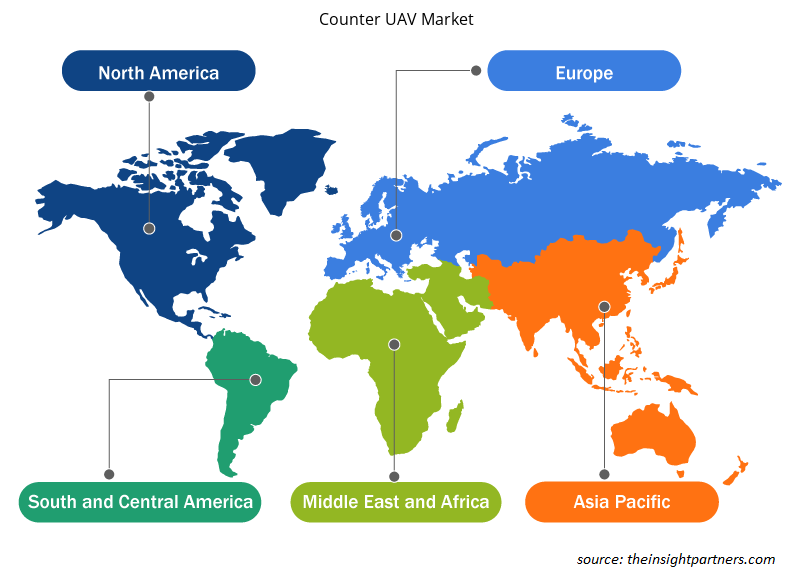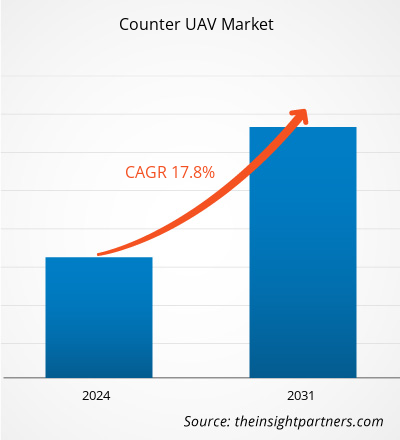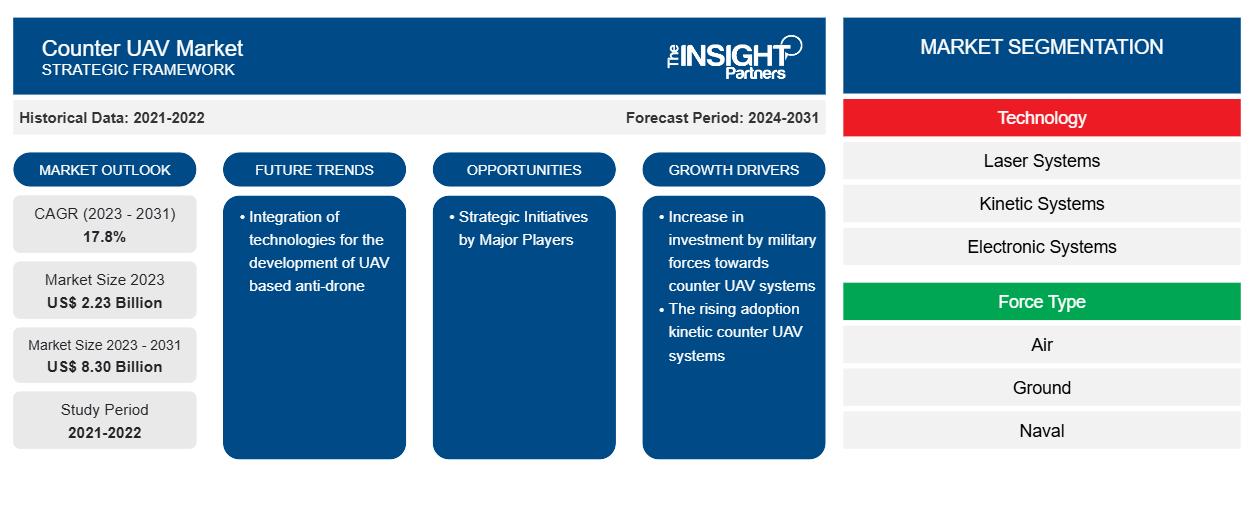Si prevede che la dimensione del mercato dei contro-UAV raggiungerà gli 8,30 miliardi di dollari entro il 2031, rispetto ai 2,23 miliardi di dollari del 2023. Si prevede che il mercato registrerà un CAGR del 17,8% nel periodo 2023-2031. È probabile che l'integrazione delle tecnologie per lo sviluppo di sistemi anti-drone basati su UAV rimanga una tendenza chiave nel mercato.
Analisi del mercato dei contro-UAV
Lockheed Martin Corporation, Thales Group, Northrop Grumman Corporation, Leonardo SpA e Rafael Advanced Defense Systems Ltd sono tra i principali attori del mercato che operano nel mercato globale dei contro UAV. Gli attori principali sono elencati considerando fattori quali fatturato complessivo, attuale portafoglio di prodotti contro UAV, portata geografica, iniziative di mercato, investimenti in aggiornamenti tecnologici, partnership e altre attività correlate al mercato.
Panoramica del mercato dei contro-UAV
I principali stakeholder nell'ecosistema del mercato globale dei contro UAV includono produttori di componenti, integratori di sistema e utenti finali, tra gli altri. Un radar di sistema anti-UAV è composto da vari componenti, come sensori e sistemi GPS , che vengono acquistati dai produttori di sistemi da un'enorme base di produttori di componenti. Questi produttori di componenti forniscono le parti di base ai player del mercato globale dei contro UAV. Gli integratori di sistema sono le aziende che si occupano della produzione dei sistemi anti-drone dopo aver integrato ogni componente. Alcuni dei principali player che operano nel mercato includono Raytheon Technologies Corporation, Rafael Advanced Defense Systems Ltd., Thales Group, Lockheed Martin Corporation e Israel Aerospace Industries Ltd. tra gli altri. L'utente finale del mercato globale dei contro UAV include forze aeree, terrestri e navali impegnate nella difesa e nella sicurezza interna dei paesi. Le soluzioni anti-UAV hanno anche registrato un aumento nell'adozione da parte delle forze di sicurezza interna per eventi e concerti globali privati. Pertanto, l'aumento della spesa militare da parte dei paesi sviluppati e in via di sviluppo e i loro crescenti investimenti per garantire la sicurezza dai droni ostili sia lungo i confini terrestri che costieri stanno anche favorendo l'adozione di soluzioni anti-UAV in tutto il mondo.
Personalizza questo report in base alle tue esigenze
Riceverai la personalizzazione gratuita di qualsiasi report, comprese parti di questo report, o analisi a livello nazionale, pacchetto dati Excel, oltre a usufruire di grandi offerte e sconti per start-up e università
-
Scopri le principali tendenze di mercato in questo rapporto.Questo campione GRATUITO includerà analisi di dati che spaziano dalle tendenze di mercato alle stime e alle previsioni.
Driver e opportunità del mercato dei droni anti-drone
Crescente adozione di sistemi di contatori cinetici UAV
I sistemi Kinetic Counter UAV sono utilizzati da corpi militari in tutto il mondo per abbattere completamente un drone. Utilizza linee di peso o reti anti-drone che vengono generalmente lanciate con l'aiuto di aria compressa o di un altro UAV. Questi dispositivi aiutano a catturare il drone, neutralizzarlo o distruggerlo. A volte, droni sconosciuti vengono inviati entro i confini militari per studiare l'area o per tenere d'occhio da vicino la posizione degli avversari. In tali casi, la distruzione completa del drone garantisce una maggiore sicurezza alle forze militari.
Alcune delle principali aziende che offrono sistemi cinetici di contrasto ai droni includono KWESST Micro Systems Inc. e Zen Technologies Limited tra le altre. KWESST Micro Systems Inc. offre micro-droni per l'interdizione cinetica di piccoli droni, compresi gli sciami, che possono essere lanciati dai soldati. È un drone completamente automatico che aiuta nell'identificazione dei droni, nel tracciamento, nella caccia e nella neutralizzazione con la tecnologia cinetica. Questi sistemi coprono anche una portata di 4 km. Nell'ottobre 2021, l'azienda ha annunciato lo sviluppo di un nuovo sistema di contrasto ai droni in risposta alla minaccia in rapida crescita delle munizioni vaganti.
Iniziative strategiche dei principali attori
I crescenti attacchi terroristici e l'instabilità politica tra vari paesi sviluppati e in via di sviluppo stanno aumentando le forze di difesa e di sicurezza interna per aumentare il loro approvvigionamento di soluzioni avanzate come sistemi radar, sistemi di comunicazione e tecnologie anti-drone tra gli altri. Ad esempio, il dipartimento della difesa degli Stati Uniti, dell'Unione Europea e altre autorità come il ministero della difesa indiano hanno aumentato la loro spesa per l'approvvigionamento di anti-droni nel corso degli anni. Ciò sta portando i produttori di anti-UAV ad adottare strategie di crescita organiche e inorganiche, come investimenti elevati, offerte di prodotti ed espansione globale, creando ulteriori opportunità di crescita per il mercato globale anti-UAV.
Analisi della segmentazione del rapporto di mercato dei contro-UAV
I segmenti chiave che hanno contribuito alla derivazione dell'analisi di mercato dei contromisure UAV sono la tecnologia, il tipo di forza, il tipo di prodotto, la configurazione e gli utenti finali.
- In base alla tecnologia, il mercato dei counter UAV è segmentato in sistemi laser, sistemi cinetici e sistemi elettronici. Il segmento dei sistemi elettronici ha detenuto una quota di mercato maggiore nel 2023.
- In base al tipo di forza, il mercato dei contro-UAV è segmentato in aereo, terrestre e navale. Il segmento terrestre ha detenuto una quota di mercato maggiore nel 2023.
- In base al tipo di prodotto, il mercato dei counter UAV è segmentato in terrestre e portatile. Il segmento terrestre ha detenuto una quota di mercato maggiore nel 2023.
- In base alla configurazione, il mercato dei counter UAV è diviso in portatile e stazionario. Il segmento stazionario ha detenuto una quota di mercato maggiore nel 2023.
- In base alla configurazione, il mercato dei counter UAV è suddiviso in difesa e sicurezza nazionale. Il segmento della difesa ha detenuto una quota di mercato maggiore nel 2023.
Analisi della quota di mercato dei contro-UAV per area geografica
L'ambito geografico del rapporto sul mercato dei droni da combattimento è suddiviso principalmente in quattro regioni: Nord America, Europa, Asia Pacifico e resto del mondo.
Il Nord America ha dominato il mercato nel 2023, seguito da Europa e regioni dell'Asia Pacifica. Inoltre, è probabile che anche l'Asia Pacifica registri il CAGR più elevato nei prossimi anni. Gli Stati Uniti hanno rappresentato la quota maggiore nel mercato nordamericano dei sistemi anti-UAV. I sistemi anti-UAV, secondo il Dipartimento della Difesa degli Stati Uniti (DOD), aiutano l'esercito statunitense a rilevare e neutralizzare droni ostili o aggressivi. A causa delle loro dimensioni, del materiale di costruzione e dell'altitudine di volo, molti UAS più piccoli non sono rilevabili dai tipici sistemi di difesa aerea. Di conseguenza, il Dipartimento della Difesa degli Stati Uniti (DOD) prevede di spendere almeno 636 milioni di dollari USA in ricerca e sviluppo sui sistemi anti-UAS (C-UAS) nell'anno fiscale 2022, nonché almeno 75 milioni di dollari USA in acquisti di C-UAS, un aumento di 134 milioni di dollari USA rispetto all'anno fiscale 2021. Mentre il Dipartimento della Difesa degli Stati Uniti continua a sviluppare, acquistare e distribuire queste tecnologie, contribuendo alla crescita del mercato.
Approfondimenti regionali sul mercato dei droni da combattimento
Le tendenze regionali e i fattori che influenzano il mercato Counter UAV durante il periodo di previsione sono stati ampiamente spiegati dagli analisti di Insight Partners. Questa sezione discute anche i segmenti e la geografia del mercato Counter UAV in Nord America, Europa, Asia Pacifico, Medio Oriente e Africa e America meridionale e centrale.

- Ottieni i dati specifici regionali per il mercato dei droni da combattimento
Ambito del rapporto sul mercato dei contro-UAV
| Attributo del report | Dettagli |
|---|---|
| Dimensioni del mercato nel 2023 | 2,23 miliardi di dollari USA |
| Dimensioni del mercato entro il 2031 | 8,30 miliardi di dollari USA |
| CAGR globale (2023-2031) | 17,8% |
| Dati storici | 2021-2022 |
| Periodo di previsione | 2024-2031 |
| Segmenti coperti |
Per tecnologia
|
| Regioni e Paesi coperti |
America del Nord
|
| Leader di mercato e profili aziendali chiave |
|
Densità degli attori del mercato: comprendere il suo impatto sulle dinamiche aziendali
Il mercato Counter UAV Market sta crescendo rapidamente, spinto dalla crescente domanda degli utenti finali dovuta a fattori quali l'evoluzione delle preferenze dei consumatori, i progressi tecnologici e una maggiore consapevolezza dei vantaggi del prodotto. Con l'aumento della domanda, le aziende stanno ampliando le loro offerte, innovando per soddisfare le esigenze dei consumatori e capitalizzando sulle tendenze emergenti, il che alimenta ulteriormente la crescita del mercato.
La densità degli operatori di mercato si riferisce alla distribuzione di aziende o società che operano in un particolare mercato o settore. Indica quanti concorrenti (operatori di mercato) sono presenti in un dato spazio di mercato in relazione alle sue dimensioni o al valore di mercato totale.
Le principali aziende che operano nel mercato dei sistemi anti-UAV sono:
- Sistema di sorveglianza Blighter Ltd
- Dedrone
- Scudo per droni
- Società Aerospaziale Israeliana Ltd.
- Leonardo SPA
Disclaimer : le aziende elencate sopra non sono classificate secondo un ordine particolare.

- Ottieni una panoramica dei principali attori del mercato dei droni da banco
Notizie e sviluppi recenti sul mercato dei contro-UAV
Il mercato dei contro UAV viene valutato raccogliendo dati qualitativi e quantitativi dopo la ricerca primaria e secondaria, che include importanti pubblicazioni aziendali, dati associativi e database. Di seguito sono elencati alcuni degli sviluppi nel mercato dei contro UAV:
- Elbit Systems presenta una nuova e unica capacità di guerra elettronica (EW) al Paris Airshow come parte della sua suite EW unificata. La nuova capacità è fornita tramite i ricevitori di avviso radar (RWR) digitali, una parte della comprovata suite EW di autoprotezione aerea di Elbit, e consente il rilevamento e l'identificazione dei droni, nonché la localizzazione del Personal Location Beacon (PLB) delle forze di terra e dei piloti. (Fonte: Elbit Systems Ltd, comunicato stampa, giugno 2023)
- Elbit Systems Ltd (NASDAQ:ESLT e TASE: ESLT) Elbit Systems ha annunciato oggi di essersi aggiudicata un contratto del valore di circa 55 milioni di $ per la fornitura di sistemi aerei senza pilota (C-UAS) ReDrone Counter multistrato ai Paesi Bassi. Il contratto verrà eseguito nell'arco di quattro anni. (Fonte: Elbit Systems Ltd, comunicato stampa, agosto 2023)
Copertura e risultati del rapporto sul mercato dei contro-UAV
Il rapporto “Dimensioni e previsioni del mercato dei dispositivi anti-UAV (2021-2031)” fornisce un’analisi dettagliata del mercato che copre le seguenti aree:
- Dimensioni e previsioni del mercato dei contromisure UAV a livello globale, regionale e nazionale per tutti i segmenti di mercato chiave coperti dall'ambito
- Contrastare le tendenze del mercato dei droni e le dinamiche di mercato come i conducenti, i vincoli e le opportunità chiave
- Analisi dettagliata delle cinque forze di Porter
- Analisi di mercato dei contromisure UAV che copre le principali tendenze del mercato, il quadro globale e regionale, i principali attori, le normative e i recenti sviluppi del mercato
- Analisi del panorama industriale e della concorrenza che copre la concentrazione del mercato, l'analisi della mappa di calore, i principali attori e gli sviluppi recenti per il mercato dei contromisure UAV
- Profili aziendali dettagliati
- Analisi storica (2 anni), anno base, previsione (7 anni) con CAGR
- Analisi PEST e SWOT
- Valore/volume delle dimensioni del mercato - Globale, Regionale, Nazionale
- Industria e panorama competitivo
- Set di dati Excel
Report recenti
Testimonianze
Motivo dell'acquisto
- Processo decisionale informato
- Comprensione delle dinamiche di mercato
- Analisi competitiva
- Analisi dei clienti
- Previsioni di mercato
- Mitigazione del rischio
- Pianificazione strategica
- Giustificazione degli investimenti
- Identificazione dei mercati emergenti
- Miglioramento delle strategie di marketing
- Aumento dell'efficienza operativa
- Allineamento alle tendenze normative























 Ottieni un campione gratuito per - Mercato dei droni da contrasto
Ottieni un campione gratuito per - Mercato dei droni da contrasto